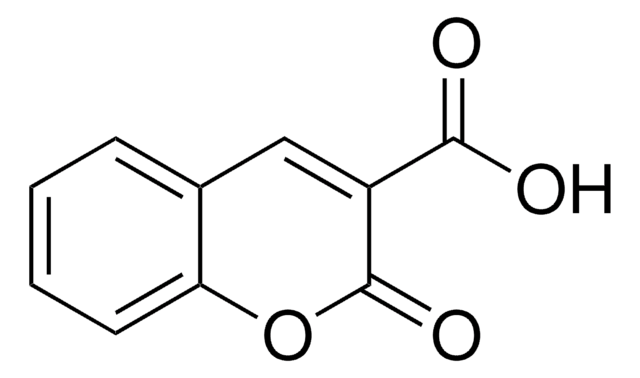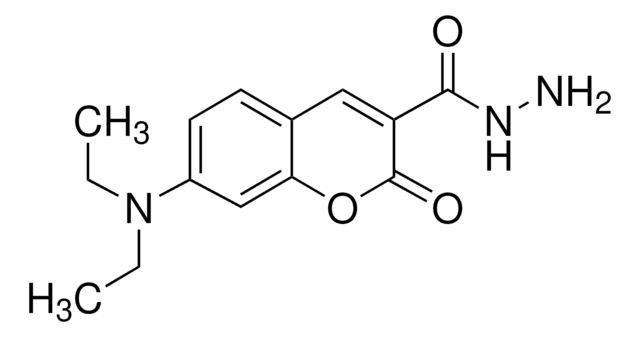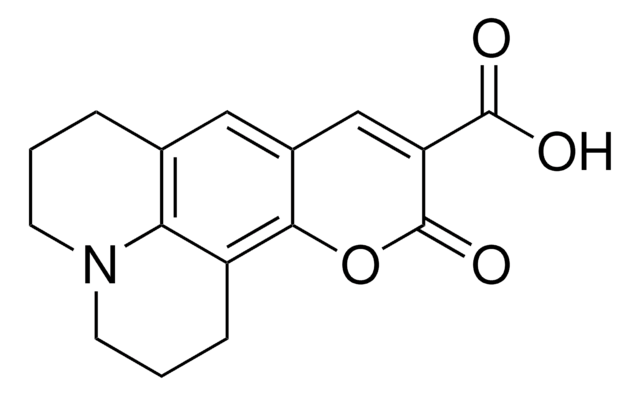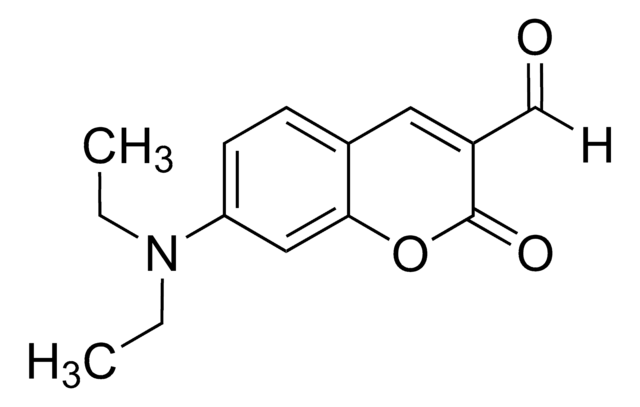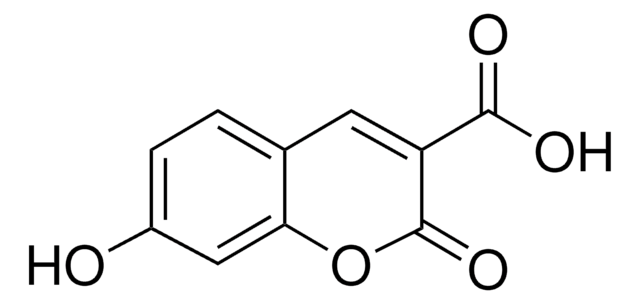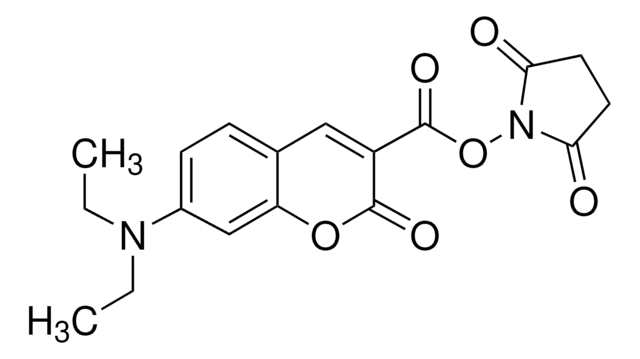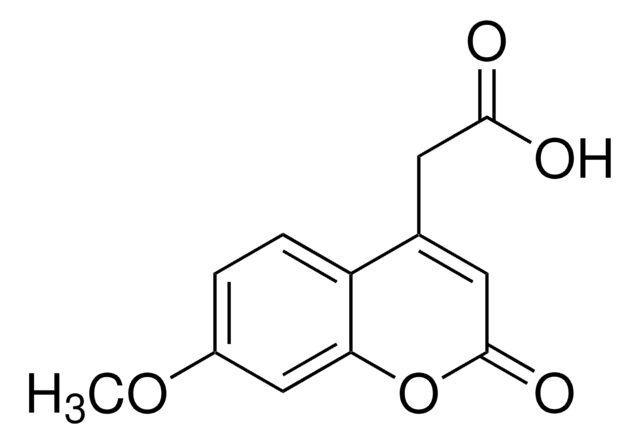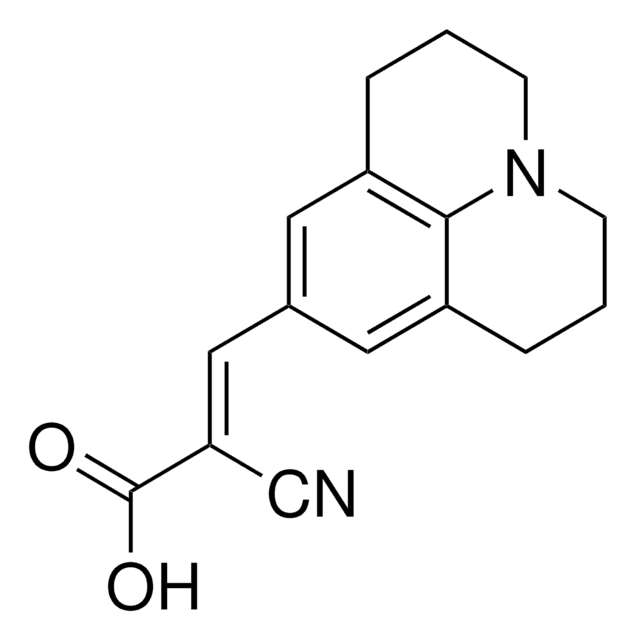36799
7-(Diethylamino)coumarin-3-carboxylic acid
BioReagent, suitable for fluorescence, ≥98.0% (HPCE)
Sign Into View Organizational & Contract Pricing
All Photos(1)
About This Item
Empirical Formula (Hill Notation):
C14H15NO4
CAS Number:
Molecular Weight:
261.27
Beilstein:
6145963
MDL number:
UNSPSC Code:
12352106
PubChem Substance ID:
NACRES:
NA.32
Recommended Products
product line
BioReagent
Quality Level
Assay
≥98.0% (HPCE)
mp
222-224 °C (dec.) (lit.)
solubility
DMF: soluble
DMSO: soluble
fluorescence
λex 409 nm; λem 473 nm in 0.1 M Tris pH 9.0
suitability
suitable for fluorescence
SMILES string
CCN(CC)c1ccc2C=C(C(O)=O)C(=O)Oc2c1
InChI
1S/C14H15NO4/c1-3-15(4-2)10-6-5-9-7-11(13(16)17)14(18)19-12(9)8-10/h5-8H,3-4H2,1-2H3,(H,16,17)
InChI key
WHCPTFFIERCDSB-UHFFFAOYSA-N
Application
7-(Diethylamino)coumarin-3-carboxylic acid (7-DCCA) may be used to study its photophysical properties in various solvents and solvent mixtures and as a fluorescent label for amine modification and protein conjugation
Packaging
Bottomless glass bottle. Contents are inside inserted fused cone.
Other Notes
Fluorescent label for amine modification and protein conjugation
Storage Class Code
11 - Combustible Solids
WGK
WGK 3
Flash Point(F)
Not applicable
Flash Point(C)
Not applicable
Personal Protective Equipment
dust mask type N95 (US), Eyeshields, Gloves
Choose from one of the most recent versions:
Already Own This Product?
Find documentation for the products that you have recently purchased in the Document Library.
Customers Also Viewed
Alicia S Kriete et al.
Interface focus, 9(4), 20190013-20190013 (2019-07-03)
Urinary incontinence is a significant challenge for women who are affected by it. We propose augmenting the tissue structure to restore normal biomechanics by molecularly engineering the tissue using a novel family of biomimetic proteoglycans (BPGs). This work examines the
Simone Kunzelmann et al.
Biochemistry, 49(5), 843-852 (2009-12-24)
A single-stranded DNA binding protein (SSB), labeled with a fluorophore, interacts with single-stranded DNA (ssDNA), giving a 6-fold increase in fluorescence. The labeled protein is the adduct of the G26C mutant of the homotetrameric SSB from Escherichia coli and a
J R Leisey et al.
The American journal of physiology, 267(2 Pt 2), H645-H653 (1994-08-11)
Quantitation of metabolic parameters using the technique of cardiac surface fluorescence is complicated by motion and changes in tissue absorption. Because ratio fluorescence methodology can be applied to eliminate motion-induced errors, in the current study, we used a ratio fluorescence
A Kakio et al.
The Journal of biological chemistry, 276(27), 24985-24990 (2001-05-09)
GM1 ganglioside-bound amyloid beta-protein (GM1/Abeta), found in brains exhibiting early pathological changes of Alzheimer's disease (AD) including diffuse plaques, has been suggested to be involved in the initiation of amyloid fibril formation in vivo by acting as a seed. To
Protamine-like proteins have bactericidal activity. The first evidence in Mytilus galloprovincialis.
Rosaria Notariale et al.
Acta biochimica Polonica, 65(4), 585-594 (2018-11-18)
The major acid-soluble protein components of the mussel Mytilus galloprovincialis sperm chromatin consist of the protamine-like proteins PL-II, PL-III and PL-IV, an intermediate group of sperm nuclear basic proteins between histones and protamines. The aim of this study was to
Our team of scientists has experience in all areas of research including Life Science, Material Science, Chemical Synthesis, Chromatography, Analytical and many others.
Contact Technical Service